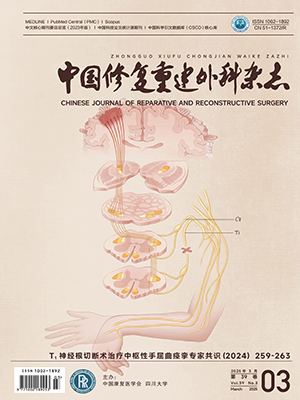To detect the cell density, apoptotic incidence and the expressions of Bax and Caspase-3
in human lumbar intervertebral discs, so as to further understand the mechanism of human lumbar intervertebral disc
degeneration and provide a new idea for biologic treatment of it in future. Methods From May to December in 2006,
30 human lumbar intervertebral discs in experimental group(L2 to S1)were surgically collected from 27 patients undergoing posterior lumbar intervertebral discoidectomy and fusion. All the cases were affirmed by MRI and they never experienced discography, collagenolysis of nucleus pulposus and percutaneous laser disc decompression. The control group consisted of 20 human lumbar intervertebral discs(L2 to S1)harvested from 5 young men without spine-related condition immediately after their accidental death. Apoptotic disc cells were detected by TUNEL and histomorphology, and immunohistochemical staining with SP method was performed to examine the expressions of Bax and Caspase-3 in all specimens. Results HE staining disclosed that the average cell density in control group (17.16 ± 1.22)/HP was higher than that in experimental group (12.41 ± 0.95)/HP (P lt; 0.01). However, TUNEL staining observed that the average TUNEL positive incidence in control group (6.97% ± 0.92%) was lower than that in experimental group (12.59% ± 0.95%), (P lt; 0.01). Immunohistochemical staining with SP method showed that the Bax and Caspase-3 positive incidence of nucleus pulposus in control group (11.02% ± 1.18%, 9.01% ± 1.00%) were lower than those in experimental group (19.29% ± 1.18%, 15.07% ± 0.97%), (P lt; 0.01). The results of the average gray scale value of nucleus pulposus in control group were 187.33 ± 7.88 and 185.68 ± 3.26, respectively, with 124.98 ±6.69 and 160.13 ± 4.37 in experimental group. There was significant difference between the two groups (P lt; 0.01). When the
total 50 specimens in the two groups were analyzed, TUNEL positive incidence showed significant inverse correlations with their respectively corresponding cell densities (r = - 0.88, r = - 0.93, P lt; 0.01). The Bax and Caspase-3 positive incidence of nucleus pulposus showed significant positive correlation with the TUNEL positive incidence of nucleus pulposus (r = 0.83, r = 0.91, P lt; 0.01). Conclusion The decrease of cell density is involved in the development of human lumbar intervertebral disc degeneration. Bax and Caspase-3 might play a role in disc cell apoptosis in nucleus pulposus of human lumbar intervertebral disc.
Citation: WANG Dongqi,LIU Miao,SONG Huanjin,WANG Min,YANG Kangping,ZHANG Yingang. EXPRESSION OF BAX AND CASPASE-3 AND APOPTOSIS IN HUMAN LUMBAR INTERVERTEBRAL DISCDEGENERATION. Chinese Journal of Reparative and Reconstructive Surgery, 2008, 22(4): 421-425. doi: Copy
Copyright © the editorial department of Chinese Journal of Reparative and Reconstructive Surgery of West China Medical Publisher. All rights reserved




